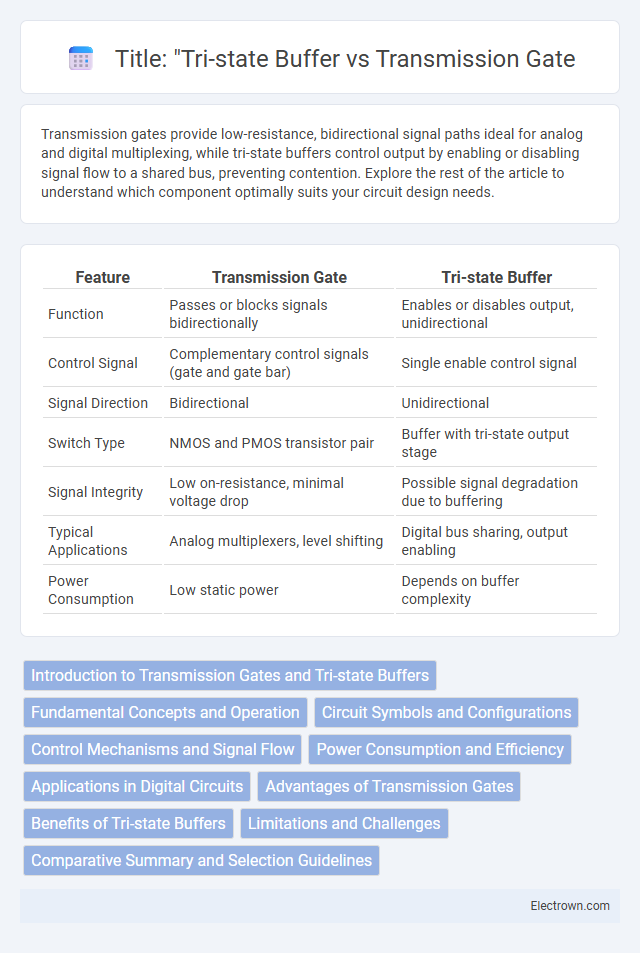Transmission gates provide low-resistance, bidirectional signal paths ideal for analog and digital multiplexing, while tri-state buffers control output by enabling or disabling signal flow to a shared bus, preventing contention. Explore the rest of the article to understand which component optimally suits your circuit design needs.
Table of Comparison
| Feature | Transmission Gate | Tri-state Buffer |
|---|---|---|
| Function | Passes or blocks signals bidirectionally | Enables or disables output, unidirectional |
| Control Signal | Complementary control signals (gate and gate bar) | Single enable control signal |
| Signal Direction | Bidirectional | Unidirectional |
| Switch Type | NMOS and PMOS transistor pair | Buffer with tri-state output stage |
| Signal Integrity | Low on-resistance, minimal voltage drop | Possible signal degradation due to buffering |
| Typical Applications | Analog multiplexers, level shifting | Digital bus sharing, output enabling |
| Power Consumption | Low static power | Depends on buffer complexity |
Introduction to Transmission Gates and Tri-state Buffers
Transmission gates function as bidirectional switches, enabling or blocking signal paths in integrated circuits by using complementary MOSFETs controlled by a gate signal. Tri-state buffers, on the other hand, control the output driver to produce one of three states: high, low, or high-impedance, effectively isolating the output from the circuit when disabled. Both components are essential for managing signal flow and bus sharing in digital systems, with transmission gates providing analog-level transmission and tri-state buffers controlling digital output states.
Fundamental Concepts and Operation
A transmission gate operates as a bidirectional switch using complementary MOSFETs to pass or block signals efficiently with low resistance, controlled by a single control signal and its complement. A tri-state buffer functions as a unidirectional device that can drive an output high, low, or place it in a high-impedance state, enabling multiple devices to share a common bus without interference. Transmission gates excel in analog signal transmission and switching applications, while tri-state buffers are widely used in digital circuits for bus interfacing and avoiding output contention.
Circuit Symbols and Configurations
Transmission gates are represented by a symbol combining both NMOS and PMOS transistors controlled by complementary signals, enabling bidirectional current flow when activated. Tri-state buffers use a single transistor symbol with an enable input that switches the output between high, low, and high-impedance states, effectively isolating the output line. Your circuit design choice depends on whether you require bidirectional signal passing (transmission gate) or controlled output driving with high-impedance state (tri-state buffer).
Control Mechanisms and Signal Flow
Transmission gates use complementary MOSFET pairs controlled by a single control signal and its inverse, allowing bidirectional signal flow without voltage drop, ideal for analog and digital multiplexing. Tri-state buffers employ a control input to toggle the output between active driving and high-impedance states, effectively isolating the bus when not in use and enabling unidirectional signal flow. Control mechanisms in transmission gates facilitate seamless signal transmission by enabling or disabling conduction, while tri-state buffers control signal flow by driving or tri-stating outputs to prevent bus contention.
Power Consumption and Efficiency
Transmission gates offer lower power consumption than tri-state buffers by eliminating static current leakage when switching between on and off states, making them ideal for low-power applications. Tri-state buffers, while simpler, can have higher power draw due to the inherent leakage currents during the high-impedance state, reducing overall efficiency. Your choice between these components should consider the specific power budget and switching speed requirements for optimal circuit performance.
Applications in Digital Circuits
Transmission gates excel in multiplexers and pass transistors for analog and digital signals due to their low voltage drop and bidirectional conduction. Tri-state buffers are ideal for bus systems and data lines where multiple outputs need controlled access to a common line without interference. Understanding your circuit's need for signal integrity and control helps determine whether a transmission gate or tri-state buffer is more suitable.
Advantages of Transmission Gates
Transmission gates provide low resistance paths in both ON and OFF states, ensuring minimal signal degradation and better voltage levels compared to tri-state buffers. They offer symmetric switching characteristics for both pull-up and pull-down operations, allowing seamless transmission of analog and digital signals. Their bidirectional functionality and lower static power consumption make transmission gates ideal for multiplexers and bus switches in integrated circuits.
Benefits of Tri-state Buffers
Tri-state buffers offer the key benefit of enabling multiple devices to share a single data bus without interference by providing high-impedance output states, effectively disconnecting the buffer when not in use. This allows Your circuits to efficiently implement bus systems and reduce wiring complexity while preventing contention. Unlike transmission gates, tri-state buffers simplify control logic by offering clear enable/disable signals that improve overall system reliability.
Limitations and Challenges
Transmission gates face limitations such as increased resistance and signal degradation at higher frequencies, which can affect analog and digital signal integrity. Tri-state buffers struggle with challenges including bus contention risks and increased power consumption when improperly controlled, leading to potential data corruption. Your choice between these devices should consider these constraints to ensure optimal circuit performance and reliability.
Comparative Summary and Selection Guidelines
Transmission gates offer bidirectional signal flow and low on-resistance, making them ideal for analog multiplexing and switch applications, while tri-state buffers excel in digital circuits by enabling or disabling outputs to prevent bus contention. Your choice depends on whether you require analog signal integrity and minimal voltage drop (transmission gate) or clear digital logic isolation with defined high-impedance states (tri-state buffer). For mixed-signal environments or precision analog control, transmission gates are preferable; tri-state buffers suit digital bus control and driving multiple devices on shared lines.
Transmission Gate vs Tri-state Buffer Infographic

 electrown.com
electrown.com